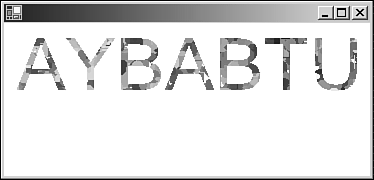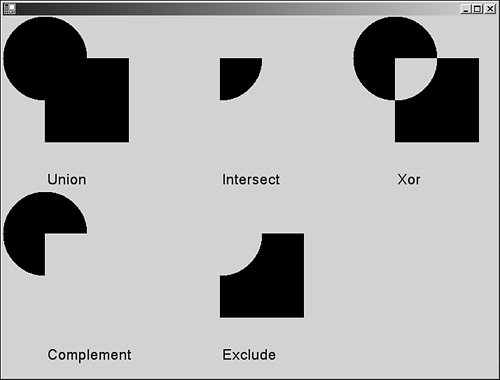Clipping with Paths and Regions
| I l @ ve RuBoard |
Clipping with Paths and RegionsA region is a description of some enclosed shape that can be used as a mask in which to perform graphical operations. Regions can be regular shapes, like rectangles or ellipses; they can also be irregular, perhaps created from curves or text glyphs. Because regions can be created from paths, it is possible to have very complex, clipped shapes . Going back again to our previous text path example, we can create a clipping region from it and use it for other interesting things. In the example shown in Listing 3.5.6, we use a path, filled with a text string, as a mask for randomly positioned ellipses of color that splatter the window but are clipped by the glyph outlines of the text. Listing 3.5.6 ClipToPath.cs: Using a Path to Clip the Drawing Area 1: using System; 2: using System.Drawing; 3: using System.Drawing.Drawing2D; 4: using System.Collections; 5: using System.ComponentModel; 6: using System.Windows.Forms; 7: using System.Data; 8: 9: namespace Clipping 10: { 11: public class ClipToPath : System.Windows.Forms.Form 12: { 13: 14: Timer timer; 15: GraphicsPath p; 16: bool dirty; 17: 18: void OnPaint(object sender, PaintEventArgs e) 19: { 20: Random r=new Random(); 21: SolidBrush brush = new SolidBrush( 22: Color.FromArgb(r.Next(255), 23: r.Next(255), 24: r.Next(255))); 25: e.Graphics.SetClip(p); 26: e.Graphics.FillEllipse(brush, 27: r.Next(500), 28: r.Next(200), 29: r.Next(20), 30: r.Next(20)); 31: brush.Dispose(); 32: } 33: 34: void OnTick(object sender, EventArgs e) 35: { 36: Invalidate(); 37: } 38: 39: protected override void OnPaintBackground(PaintEventArgs e) 40: { 41: if(dirty) 42: { 43: e.Graphics.ResetClip(); 44: SolidBrush b=new SolidBrush(this.BackColor); 45: e.Graphics.FillRectangle(b, this.ClientRectangle); 46: dirty = false; 47: b.Dispose(); 48: } 49: } 50: 51: void OnSized(object sender, EventArgs e) 52: { 53: dirty=true; 54: Invalidate(); 55: } 56: 57: public ClipToPath() 58: { 59: 60: p=new GraphicsPath(); 61: p.AddString("AYBABTU",FontFamily.GenericSansSerif, 62: 0,(float)72,new Point(0,0), 63: StringFormat.GenericDefault); 64: dirty=true; 65: this.Paint+=new PaintEventHandler(OnPaint); 66: this.SizeChanged+=new EventHandler(OnSized); 67: timer = new Timer(); 68: timer.Interval=10; 69: timer.Tick+=new EventHandler(OnTick); 70: timer.Enabled=true; 71: } 72: 73: static void Main() 74: { 75: Application.Run(new ClipToPath()); 76: } 77: } 78: } The path is created once on lines 59 “62 and stored for use later. Then a timer is initialized to enable the periodic refresh of the page. Lines 39 “48 handle the repaint of the background if the window is resized or on the first draw. Finally, line 25 selects the clip-path into the Graphics object. The following lines place a random blob of color on the page; this might or might not be seen, depending on its coincidence with the clipping path. After a while, the output from the application looks something like the image in Figure 3.5.8. Figure 3.5.8. Painting clipped to a path. Operations on regions are different from those on paths. A path specifies a set of boundaries, a region specifies an area or group of areas to be used as a mask. Regions can be combined in several ways. The operation is controlled by the CombineMode enumeration. Listing 3.5.7 illus trates the use of regions in four different modes. Listing 3.5.7 Regions.cs: Combining Regions in Different Ways 1: using System; 2: using System.Drawing; 3: using System.Drawing.Drawing2D; 4: using System.Collections; 5: using System.ComponentModel; 6: using System.Windows.Forms; 7: using System.Data; 8: 9: namespace regions 10: { 11: /// <summary> 12: /// Summary description for Form1. 13: /// </summary> 14: public class RegionsTest : System.Windows.Forms.Form 15: { 16: void PaintRegions(Graphics g,CombineMode m, Point offset,string text) 17: { 18: Region ra,rb; 19: GraphicsPath p=new GraphicsPath(); 20: p.AddRectangle(new Rectangle(60,60,120,120)); 21: ra=new Region(p); 22: p=new GraphicsPath(); 23: p.AddEllipse(0,0,120,120); 24: rb=new Region(p); 25: ra.Translate(offset.X,offset.Y ); 26: rb.Translate(offset.X,offset.Y); 27: g.SetClip(ra,CombineMode.Replace); 28: g.SetClip(rb,m); 29: SolidBrush brush=new SolidBrush(Color.Black); 30: g.FillRectangle(brush,this.ClientRectangle); 31: g.ResetClip(); 32: g.DrawString(text, 33: new Font("Ariel",(float)16), 34: brush,(float)offset.X+60,(float)offset.Y+220); 35: } 36: 37: void OnPaint(object sender, PaintEventArgs e) 38: { 39: // A union of two regions... 40: PaintRegions(e.Graphics,CombineMode.Union, 41: new Point(0,0),"Union"); 42: // the intersection of two regions 43: PaintRegions(e.Graphics,CombineMode.Intersect, 44: new Point(250,0),"Intersect"); 45: // Region exclusive or 46: PaintRegions(e.Graphics,CombineMode.Xor, 47: new Point(500,0),"Xor"); 48: // The complement of the two regions 49: PaintRegions(e.Graphics,CombineMode.Complement, 50: new Point(0,250),"Complement"); 51: // Exclusion. 52: PaintRegions(e.Graphics,CombineMode.Exclude, 53: new Point(250,250),"Exclude"); 54: } 55: 56: public RegionsTest() 57: { 58: this.Paint+=new PaintEventHandler(OnPaint); 59: this.Size = new Size(800,800); 60: } 61: 62: static void Main() 63: { 64: Application.Run(new RegionsTest()); 65: } 66: } 67: } OnPaint (lines 37 “54) repeatedly calls the PaintRegions method with a distinct CombineMode setting, some positional information, and an identifying string. The PaintRegions method (lines 16 “35) begins by declaring two regions, ra and rb , and filling them with a circle and a rectangle. Lines 25 and 26 ensure that the regions are moved into position ready for display, and then line 27 selects the first clip region, replacing the one that already exists in the Graphics object. The second region is combined with the CombineMode , supplied on line 28, and the whole rectangle of the client area filled with black. Note that only the area inside the clipped region is filled. The program then removes the clipping region on line 31 to draw the information text on lines 32 “34. Output from this program is shown in Figure 3.5.9. Figure 3.5.9. Exploring region combination modes. |
| I l @ ve RuBoard |
EAN: 2147483647
Pages: 204

